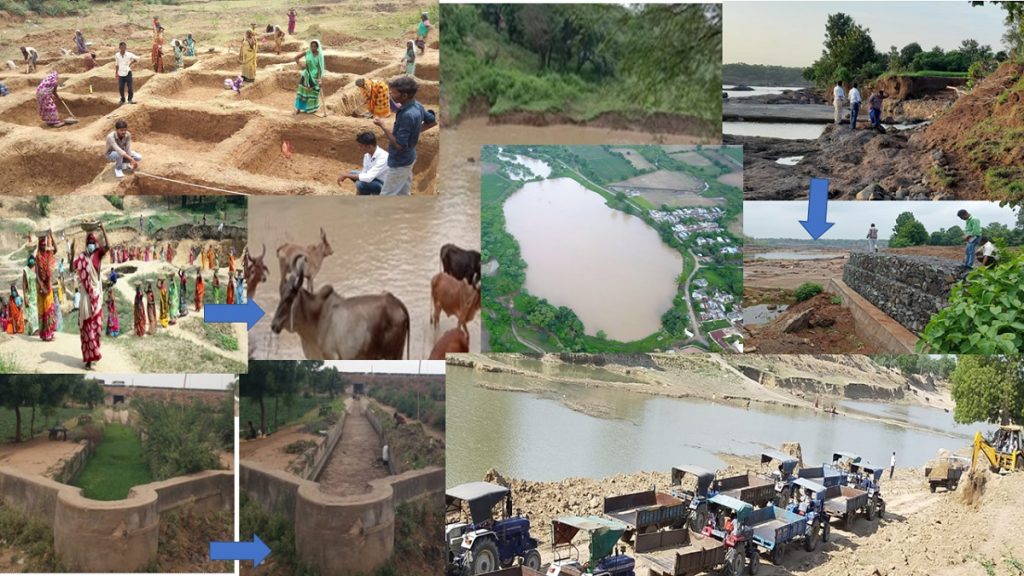Prior to 2001, Gujarat had a severe drinking water deficit. In order to provide drinking water, governments were compelled to spend billions of rupees on road tankers and in certain cases, special water trains. The State even had “water riots” because of severe water shortages that were made worse by insufficient management of water resources.
Additionally, due to the water crisis, residents of Gujarat’s drought-prone Saurashtra and Kutch migrated to Central and South areas. This human migration was usually followed by the movement of cow herds, and it led to the displacement of hundreds of thousands of people on economic, social, and cultural levels.
Gujarat saw 12 major droughts between 1980 and 2001, according to statistics from the India Meteorological Department from 2015.
The average depth of the groundwater between 1975 and 1980 in the districts of Gujarat and Kutch was 30 metres. By 2001–2002, it had dropped to 150–250 m. The groundwater level was dropping at a pace of 3-5 metres per year. The Saurashtra region, in particular Kutch, was on the brink of turning into a desert in around two decades if the situation was not quickly addressed.
State of affairs in Gujarat when Narendra Modi became CM in 2001
The story of how Gujarat transformed into national model for managing water resources began in 2001, when Narendra Modi became Chief Minister.
From his expertise as a social worker, Modi understood that the age-old issue in Gujarat could not be resolved by conventional approaches. It was necessary to implement a scientific strategy that made use of modern technology, astute planning, and assured delivery in a staggered manner.
Shortly after taking office, Modi instructed his team to improve existing canal systems rather than just rely on Narmada water, and he insisted on participatory management of drinking water and agriculture.
He broke the administrative stranglehold on projects while including NGOs and water beneficiaries from the start.
Most critically, Modi allocated money to build the infrastructure needed to distribute water.
Birth of BISAG
The Gujarat government created the state-level Bhaskaracharya Institute for Space Applications and Geoinformatics (BISAG) to aid in the supply of services and solutions for the deployment of map-based GeoSpatial Information Systems. The BISAG, a specialised institute that used satellite remote-sensing technologies and GIS-based maps to aid expedite the Gujarat infrastructure development model, was founded in 2003 as a result of the scientific attitude, with an emphasis on the use of technology. When the concept was mastered, it was applied to the water issue.
Micro-level check dams
Check dams are a traditional way of replenishing groundwater, particularly in dry locations. Gujarat had about 6,000 such check dams when Modi became CM in 2002.
One of the many reasons why this incredibly effective method of conserving and using water wasn’t expanded was a lack of understanding about where to build the dams to be more effective, as well as local political priorities. Space technology based on BISAG arrived to help.
Due to this, the total number of check dams increased from just under 6,000 to over 100,000 in only a few years, reaching 166,062 by mid-2016 with a storage capacity of more than 28,408 million cubic feet (mcf). Check dams were put in place, which greatly boosted the water supply.
At the macro level, three significant initiatives transformed the landscape of Gujarat, particularly in the Saurashtra, Kutch, and North Gujarat areas. Satellite-based planning and execution were also used in the deployment of these three major initiatives.
The Narmada Main Canal
The Narmada canal is the world’s longest irrigation canal, reaching 458 kilometres in length and transporting 40,000 cusecs of water. The system of branch canals, sub-canals, and distributaries, moreover, is what has made the Narmada canal such a transformational undertaking. PM Modi launched the Kutch branch canal from this Narmada Main canal, which helps provide water to the most distant parts.
The Sujalam Sufalam Yojana
The main goal of this initiative is to irrigate the areas of North Gujarat. Due to the deepening of lakes, check-dams, rivers, and reservoirs, which started in 2018 after a weak monsoon, the state’s water storage capacity has increased by 23,000 lakh cubic feet to date. It is a 332 km canal network that aids in bringing floodwaters from the Narmada and other rivers to the parched area of North Gujarat and supplies irrigation to around 2.2 million hectares of arable land.
The SAUNI Yojana (Saurashtra Narmada Avtaran Irrigation Yojana), which means literally “reincarnation of the Narmada River in the region,” was thus introduced. In order to transmit the extra Narmada waters to more than 115 main reservoirs and irrigate more than 1 million acres of land, a 1,126-km network of four-link pipes was designed and constructed.
Administrative and Governance reforms
The organisational structure of water resource management was also altered by Narendra Modi, who replaced the umbrella organisation with functional divisions.
The Gujarat Water Supply and Sewerage Board retained responsibility for constructing and regulating water supply and sewerage systems.
In order to give village-level institutions the competence to manage and maintain their own water supply infrastructure, the Water and Sanitation Management Organization (WASMO) was founded.
Sardar Sarovar Nigam Limited was created as an independent organisation responsible for completing the project. To transport Narmada waters, Gujarat Water Infrastructure Limited was charged with developing bulk water pipe networks.
Gujarat has been designated a ‘Har Ghar Jal’ state, which indicates that all homes in the state now have access to fresh tap water. As part of the ‘Jal Jeevan Mission,’ the project has been completed in phases throughout the years. According to state officials, all 91,73,378 houses in the state now have access to tap water.
Gujarat under Narendra Modi’s leadership has come a long way from transforming itself from water deficit to a water surplus state and also with a tap water connection in every household.

